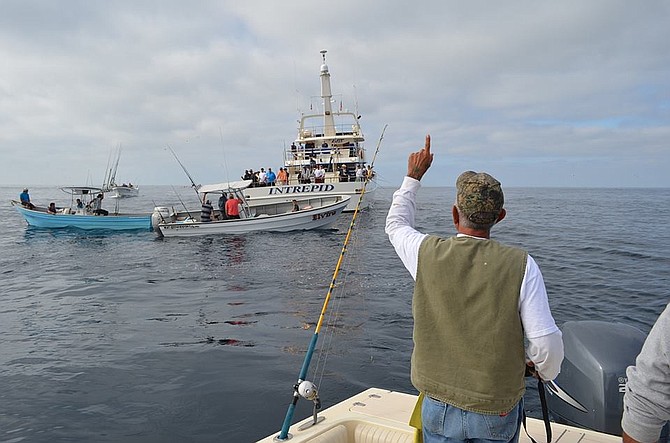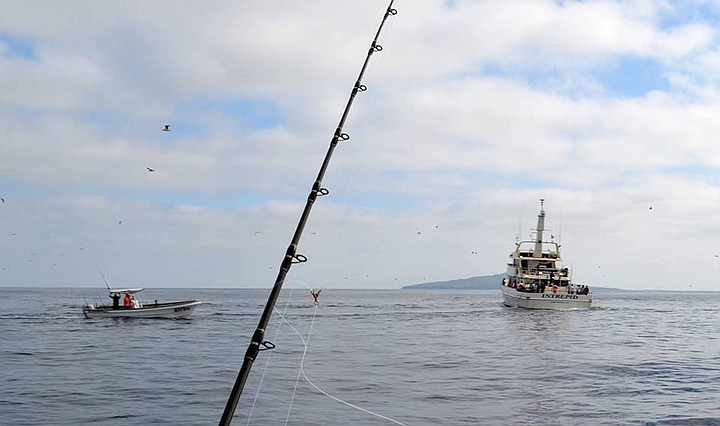 Facebook
Facebook
 X
X
 Instagram
Instagram
 TikTok
TikTok
 Youtube
Youtube

Inshore: Half-day boats are still pounding away at the calico bass. Hard to imagine the kelps from La Jolla to the Coronado Islands producing over 5,000, 14” or greater of the slow-growing bass per week, but they are. Those are only the calicos the anglers caught and kept from boats out of SD County sportfishing landings. Barracuda and bonito are biting in flurries occasionally on the chum off the kelp. Rockfish numbers are back up a bit, but I think mostly due to the boats heading down the Baja coast needing to fill a few bags for the passengers that didn’t do well on a slow outing for pelagics. A few tuna and dorado are coming over the rails for the ¾ day boats going outside while those staying near the Coronados are getting a few of those exotics, but mostly yellowtail.
Outside: Yellowfin tuna counts were back up by the end of the week after dropping off the week previous. The 2 day and longer boats have been getting solid numbers on the 10- 24 pound yellowtail off the coastal high spots while finding the tuna and dorado further outside on kelp paddies or bait balls. For you longfin hunters of old wondering where your favorite tuna are this year, the albacore are being caught closer to the Oregon/ Washington line. A trip to Westport and a ride out will get you on the prized white-meat tuna that have been mostly absent in our area for some years now.
8/7 – 8/13 Dock Totals: 6,092 anglers aboard 250 boats out of San Diego landings this past week caught 1,292 dorado, 61 bluefin tuna, 2,308 yellowfin tuna, 3,590 yellowtail, 5,254 calico bass, 47 sand bass, 1,588 rockfish, 26 lingcod, 15 sculpin, 1,327 bonito, 159 barracuda, 137 sheephead, 3 halibut, 4 white seabass, 23 mackerel, 10 whitefish and 1 cabezon

The San Quintin Battle: There was a bit of a conflict on a small high spot near San Quintin last week. Five large San Diego sportfishers parked on the 240 Bank overnight and through the morning. The 240 Bank lies about eight miles off Punta Mazo on a 240 heading. These waters are usually tough to fish for the locals and the reefs limited in area and sensitive to heavy pressure. The pangeros carry maybe 20 to 30 anglers a week in total between all operations here in San Quintin through the summer. Maybe half of those fish the 240. Five 80- to 100-foot sport vessels carrying an average of 25 anglers each put more pressure in one day on that spot than the entire local panga fleet does in a couple months. That’s not factoring in that the sportfishers have live bait and very advanced fish-finding technology.
This is by their permission (not "right") to fish anywhere in Mexico, paraphrased: Foreign-based fishing vessels cannot interfere with local operators (being anchored on a tiny bank first does not count) and they must maintain at least a 600-meter distance from those local operators. Both of these rules were violated when a San Diego boat cut off a fish by running over a pangero client’s line and then refused to leave the spot. There was a lot of yelling by some of passengers on the boats and it soon became a stand-off. Four sportfishers ceded ground and the fifth chose to push the issue until they found themselves among a handful of pangas full of mad locals buzzing around the offending vessel and telling them to go and never return.

Now, a few days later, the San Quintin pangeros are united and petitioning the Mexican officials to ban all American-based vessels from the small near-shore banks they rely on to make a living.
Scheduled fish plants (lbs): 8/19 Santee Lakes, catfish (1000)


Inshore: Half-day boats are still pounding away at the calico bass. Hard to imagine the kelps from La Jolla to the Coronado Islands producing over 5,000, 14” or greater of the slow-growing bass per week, but they are. Those are only the calicos the anglers caught and kept from boats out of SD County sportfishing landings. Barracuda and bonito are biting in flurries occasionally on the chum off the kelp. Rockfish numbers are back up a bit, but I think mostly due to the boats heading down the Baja coast needing to fill a few bags for the passengers that didn’t do well on a slow outing for pelagics. A few tuna and dorado are coming over the rails for the ¾ day boats going outside while those staying near the Coronados are getting a few of those exotics, but mostly yellowtail.
Outside: Yellowfin tuna counts were back up by the end of the week after dropping off the week previous. The 2 day and longer boats have been getting solid numbers on the 10- 24 pound yellowtail off the coastal high spots while finding the tuna and dorado further outside on kelp paddies or bait balls. For you longfin hunters of old wondering where your favorite tuna are this year, the albacore are being caught closer to the Oregon/ Washington line. A trip to Westport and a ride out will get you on the prized white-meat tuna that have been mostly absent in our area for some years now.
8/7 – 8/13 Dock Totals: 6,092 anglers aboard 250 boats out of San Diego landings this past week caught 1,292 dorado, 61 bluefin tuna, 2,308 yellowfin tuna, 3,590 yellowtail, 5,254 calico bass, 47 sand bass, 1,588 rockfish, 26 lingcod, 15 sculpin, 1,327 bonito, 159 barracuda, 137 sheephead, 3 halibut, 4 white seabass, 23 mackerel, 10 whitefish and 1 cabezon

The San Quintin Battle: There was a bit of a conflict on a small high spot near San Quintin last week. Five large San Diego sportfishers parked on the 240 Bank overnight and through the morning. The 240 Bank lies about eight miles off Punta Mazo on a 240 heading. These waters are usually tough to fish for the locals and the reefs limited in area and sensitive to heavy pressure. The pangeros carry maybe 20 to 30 anglers a week in total between all operations here in San Quintin through the summer. Maybe half of those fish the 240. Five 80- to 100-foot sport vessels carrying an average of 25 anglers each put more pressure in one day on that spot than the entire local panga fleet does in a couple months. That’s not factoring in that the sportfishers have live bait and very advanced fish-finding technology.
This is by their permission (not "right") to fish anywhere in Mexico, paraphrased: Foreign-based fishing vessels cannot interfere with local operators (being anchored on a tiny bank first does not count) and they must maintain at least a 600-meter distance from those local operators. Both of these rules were violated when a San Diego boat cut off a fish by running over a pangero client’s line and then refused to leave the spot. There was a lot of yelling by some of passengers on the boats and it soon became a stand-off. Four sportfishers ceded ground and the fifth chose to push the issue until they found themselves among a handful of pangas full of mad locals buzzing around the offending vessel and telling them to go and never return.

Now, a few days later, the San Quintin pangeros are united and petitioning the Mexican officials to ban all American-based vessels from the small near-shore banks they rely on to make a living.
Scheduled fish plants (lbs): 8/19 Santee Lakes, catfish (1000)
Comments